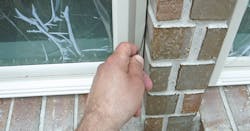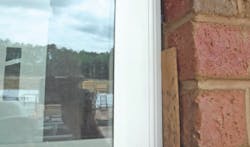Limit Cracks in Construction: Mind the Gap Between Building Materials
Some callbacks are so obvious and easily preventable that they should never happen. Yet they do. A perfect example is the improper detailing of masonry or natural stone veneer around windows and doors.
In many of the homes I see during field inspections, brick or stone veneer has been butted tight against window or door trim or frames. It may look good, but the problem is that trim materials, usually wood or vinyl, expand when temperatures and humidity rise, while brick and stone are much more stable in those conditions. When the trim or frame expands and pushes against the brick, something must give, and it’s not going to be the brick.
In many cases, the expanding trim or frame has no choice but to move away from the brick, which squeezes the window or door, causing it to bind. At that point, the builder’s only real option to relieve the pressure and keep it from happening again is to either cut the brick (in the case of a brick return) or to shave back the trim, if possible. Either way, it’s an expensive fix that most builders would rather avoid.
RELATED
Construction best practices related articles from Pro Builder's sister site ProTradeCraft.com:
Crack Prevention Tip: Leave a Gap Between Materials
Prevention is remarkably simple: just leave a 1/8-inch gap between the brick and the window, then fill it with a backer rod and high-quality sealant that meets ASTM C920 Class 25 minimum standards to absorb expansion and contraction.
Getting this right isn’t difficult and, in fact, masonry manufacturers and suppliers include shims in shipments to the jobsite that are sized to ensure a proper gap between their materials and other, dissimilar, products, namely windows and doors.
In the past, most masons knew to use those shims. But the exodus of skilled labor from the construction trades has left a workforce that doesn’t understand a lot of small but important details, including that one.
The key question is how to get today’s workers to do the job right—and consistently.
Training Trades to Get the Details Right for Better Building Performance and Fewer Callbacks
Training your trades for this detail is straightforward. Once you point out the shims (or other scrap material on site that happens to be appropriately sized for that job) and explain what to do with them (and why), most crews understand it easily and quickly.
A complicating factor is the high labor turnover in the masonry trades and the fact that you can’t count on getting the same crew for every house ... which means you have to keep an eye on it and maintain diligent training.
The builders I know who get consistently good results tend to pair training with inspections for accountability. For instance, the builder’s quality assurance manager or job supervisor might make it a point to check each house while masonry veneer is being applied. If the veneer is butted tight against a dissimilar material, the masonry sub has to pull it off and redo it, at their expense. It usually doesn’t take long before the sub’s managers are emphasizing this detail to their crews.
To be fair to everyone, builders need to include this gap in their written specifications or scopes of work and make their expectations and consequences clear to the masonry sub, as well as the trade that will apply the backer rod and sealant (usually the painter). But, of course, that’s the same requirement for any successful quality assurance effort.
Tim Kampert drives quality and performance in home building as a building performance specialist of the PERFORM Builder Solutions team at IBACOS.
Access a PDF of this article in Pro Builder's September 2019 digital edition

